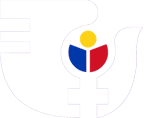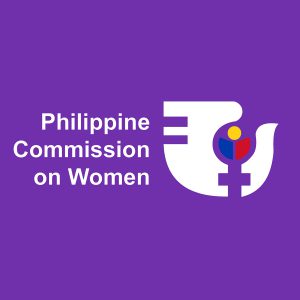Gender Equality and the Sustainable Development Goals
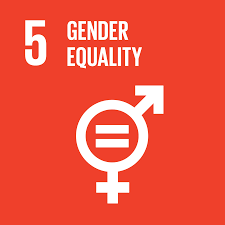
The culmination of the MDGs in 2015 called for continuity and consolidation of its results while making these more sustainable through the 2030 Agenda for Sustainable Development. In September 2015, 193 United Nations Member States gathered for the United Nations Sustainable Development Summit and adopted the new global plan of action entitled, “Transforming Our World: The 2030 Agenda for Sustainable Development.” (See UN Resolution 70/1, the 2030 Agenda). The 2030 Agenda, its 17 Goals and 169 targets, are a universal set of goals and targets aimed at eliminating poverty, protecting the planet, and improving the lives of everyone, fighting inequalities and increasing country’s productive capacity, increasing social inclusion and curbing climate change and protecting the environment, while ensuring that no one is left behind over the next fifteen years. The SDGs are designed to be a “blueprint” to achieve a better and more sustainable future for all”. The 17 sustainable development goals of the 2030 Agenda are:
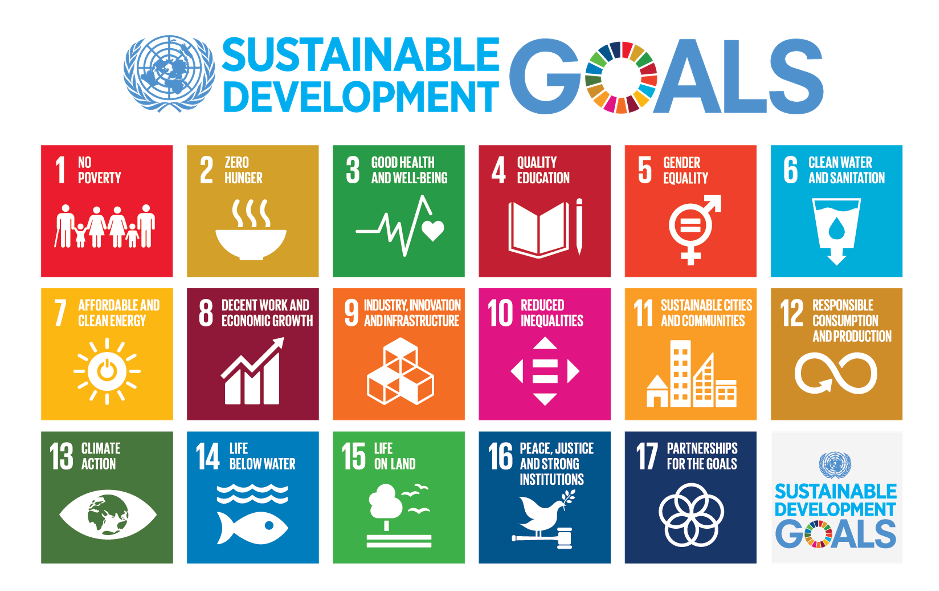
SDG 5 is aimed to “achieve gender quality and empower all women and girls”, or simply on “Gender Equality”. It has nine (9) targets and fourteen (14) indicators. SDG 5 is focused on pursuing the main goal of real and sustained gender equality in all aspects of women and girls’ lives which includes (1) ending gender disparities, (2) eliminating violence against women and girls’ lives, (3) eliminating early and forced marriage, (4) securing equal participation and opportunities for leadership, and (5) universal access to sexual and reproductive rights.
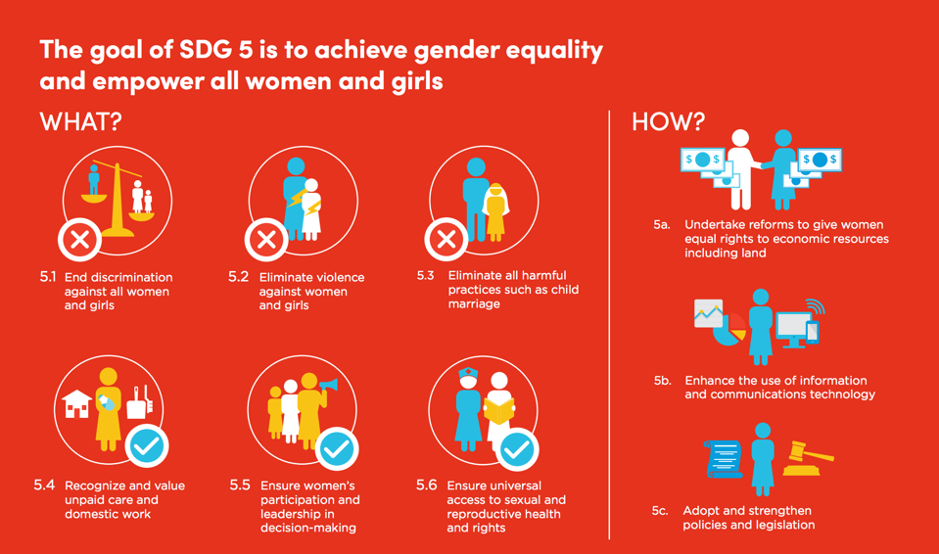
The SDG 5 targets and indicators are listed below (See also Goal 5: Gender Equality in SDG Tracker)
Sustainable Development Goal 5: Targets and Indicators
Goal 5: Achieve gender equality and empower all women and girls
| Target 5.1: End all forms of discrimination against women and girls everywhere |
| Indicator 5.1.1: Whether or not legal frameworks are in place to promote, enforce and monitor equality and non‑discrimination on the basis of sex |
| Target 5.2: Eliminate all forms of violence against all women and girls in the public and private spheres, including trafficking and sexual and other types of exploitation |
| Indicator 5.2.1: Proportion of ever-partnered women and girls aged 15 years and older subjected to physical, sexual or psychological violence by a current or former intimate partner in the previous 12 months, by form of violence and by age |
| Indicator 5.2.2: Proportion of women and girls aged 15 years and older subjected to sexual violence by persons other than an intimate partner in the previous 12 months, by age and place of occurrence |
| Target 5.3: Eliminate all harmful practices, such as child, early and forced marriage and female genital mutilation |
| Indicator 5.3.1: Proportion of women aged 20-24 years who were married or in a union before age 15 and before age 18 |
| Indicator 5.3.2: Proportion of girls and women aged 15-49 years who have undergone female genital mutilation/cutting, by age |
| Target 5.4: Recognize and value unpaid care and domestic work through the provision of public services, infrastructure and social protection policies and the promotion of shared responsibility within the household and the family as nationally appropriate |
| Indicator 5.4.1: Proportion of time spent on unpaid domestic and care work, by sex, age and location |
| Target 5.5: Ensure women’s full and effective participation and equal opportunities for leadership at all levels of decision-making in political, economic and public life |
| Indicator 5.5.1: Proportion of seats held by women in national parliaments and local governments |
| Indicator 5.5.2: Proportion of women in managerial positions |
| Target 5.6: Ensure universal access to sexual and reproductive health and reproductive rights as agreed in accordance with the Programme of Action of the International Conference on Population and Development and the Beijing Platform for Action and the outcome documents of their review conferences |
| Indicator 5.6.1: Proportion of women aged 15-49 years who make their own informed decisions regarding sexual relations, contraceptive use and reproductive health care |
| Indicator 5.6.2: Number of countries with laws and regulations that guarantee full and equal access to women and men aged 15 years and older to sexual and reproductive health care, information and education |
| Target 5.a: Undertake reforms to give women equal rights to economic resources, as well as access to ownership and control over land and other forms of property, financial services, inheritance and natural resources, in accordance with national laws |
| Indicator 5.a.1: (a) Proportion of total agricultural population with ownership or secure rights over agricultural land, by sex; and (b) share of women among owners or rights-bearers of agricultural land, by type of tenure |
| Indicator 5.a.2: Proportion of countries where the legal framework (including customary law) guarantees women’s equal rights to land ownership and/or control |
| Target 5.b: Enhance the use of enabling technology, in particular, information and communications technology, to promote the empowerment of women |
| Indicator 5.b.1: Proportion of individuals who own a mobile telephone, by sex |
| Target 5.c: Adopt and strengthen sound policies and enforceable legislation for the promotion of gender equality and the empowerment of all women and girls at all levels |
| Indicator 5.c.1: Proportion of countries with systems to track and make public allocations for gender equality and women’s empowerment |
Prioritizing gender equality is one of the cross-cutting concerns in the 2030 Agenda. Women’s empowerment and gender equality is integral to all dimensions of inclusive development. There is consensus that progress on all of the SDGs is realistically achieved if women’s empowerment and gender equality are prioritized holistically.
Translating the SDG to the Philippine Context
The conclusion of the MDGs in 2015 paved the way for the discussion of a post-2015 agenda. The focus was on building a sustainable world where environmental sustainability, social inclusion, and economic development are equally valued. The post-2015 agenda adopted an inclusive and comprehensive approach with emphasis on development as a right, with attention directed towards traditionally marginalized groups such as ethnic minorities, indigenous groups, and women.
In the interest of creating a new, people-centered, development agenda, a global consultation was conducted online and offline. Civil society organizations, citizens, scientists, academics, and the private sector from around the world were all actively engaged in the process which included activities like thematic and national consultations. In the Philippines, such activities were led by the Philippine Statistics Authority (PSA) and the National Economic and Development Authority (NEDA).
The SDGs and targets are integrated and indivisible, global in nature and universally applicable, and take into account different national realities, capacities and levels of development and respecting national policies and priorities. Each government is expected to take ownership and establish national frameworks, set nationally-owned targets guided by the global level of ambition but taking into account country-level circumstances for the achievement of 17 goals. The SDG global indicator framework which consists of 232 unique indicators was developed by the Inter-Agency and Expert Group on SDG Indicators (IAEG-SDG) established by the UN Statistical Commission.
SDG indicators were classified as follows:
Tier 1 – Indicator is conceptually clear, has an internationally established methodology and standards are available, and data are regularly produced by country;
Tier 2 – Indicator is conceptually clear, has an internationally established methodology and standards are available, but data are not regularly produced by country; and
Tier 3 – No internationally established methodology or standards are yet available for the indicator, but methodology/standards are being (or will be) developed.
In line with the Philippines’ commitment in achieving the SDGs, the PSA Board issued PSA Resolution No. 04 Series of 2016, Enjoining Government Agencies to Provide Data Support to the Sustainable Development Goals. As such, the agencies were also enjoined to monitor the country’s performance in achieving the SDGs based on the indicator framework determined by NEDA, PSA and relevant government agencies. The PSA was also designated as the official repository of the SDG indicators in the Philippines. Thereafter, multisectoral workshops and consultative meetings were conducted to assess the availability and relevance of the global SDG indicators in the country. As a result, in 2017, the PSA Board approved the Official List of SDG Indicators for Initial Monitoring in the Philippines through PSA Board Resolution No. 9, Series of 2017, with 155 indicators, of which 102 were global SDG indicators, 28 proxy indicators and 25 supplemental indicators. These indicators will be sourced from surveys, censuses and administrative data of PSA and other government agencies as well as data of international agencies.
As the official repository of the SDG indicators, PSA updates data on the country’s performance in achieving SDGs through the SDG Watch Philippines. Under the SDG Watch Philippines, 7 targets and 15 indicators were identified under the SDG 5. (See SDG Watch). To facilitate the monitoring of the country’s performance in achieving the SDGs, PSA established the SDG Focal Points consisting of the focal persons designated by the various source agencies of the SDG indicators, including the Philippine Commission on Women.
Localization of the SDG 5
Being the oversight agency in the implementation of the SDGs, NEDA has developed the SDG website, a platform that gives updates on the SDG localization initiatives of the Philippines, consisting of key government programs, activities and projects contributing to each goal.
For SDG 5, the localization initiatives are composed of the following:
- 18-Day Campaign to End Violence Against Women (VAW)
- Mapping of VAW Services, Programs, and Facilities in the Philippines
- Making VAW Desks Functional
- Strengthening Monitoring and Evaluation of the Implementation of the Gender and Women Empowerment Plan 2019-2025
- Conduct of Conferences, Fora, or Consultation Workshops Relative to the Implementation of SDG 5: Gender Equality.
The report can be found here.
